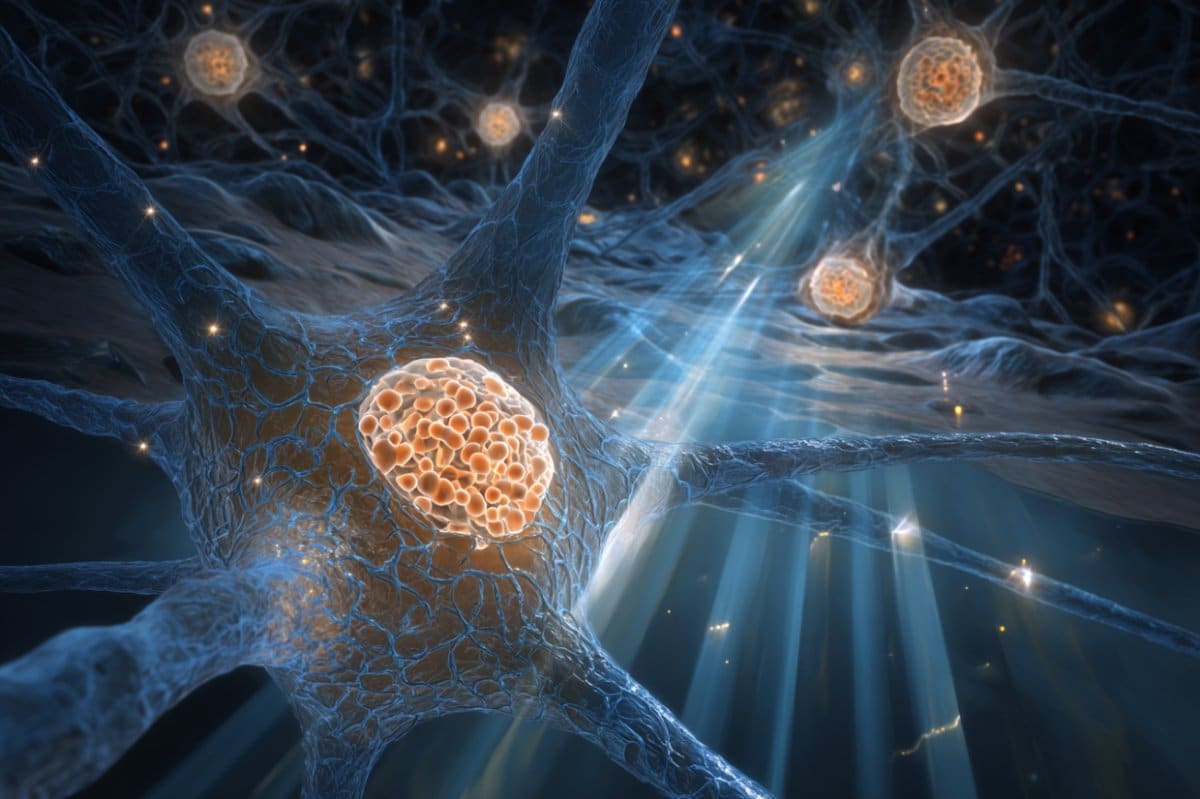Summary: New research shows that retinal neurons can rewire to preserve vision in retinitis pigmentosa, a genetic disease causing blindness. Using mouse models, scientists found that rod bipolar cells adapt by forming functional connections with cone cells when their usual rod partners degenerate.
This plasticity appears to be triggered by the degeneration process itself, not just the loss of light signals. The findings reveal how retinal circuits adapt at different disease stages and may guide therapies to slow vision loss.
Key Facts:
- Rod bipolar cells switch from rod to cone inputs as rods degenerate.
- Rewiring occurs only when rod cells die, not just when their light response fails.
- Understanding this plasticity could inform treatments to preserve vision in inherited blindness.
Source: UCLA
Scientists at the Jules Stein Eye Institute at the David Geffen School of Medicine at UCLA have discovered that certain retinal cells can rewire themselves when vision begins to deteriorate in retinitis pigmentosa, a genetic eye disease that leads to progressive blindness.
In a study using mouse models, researchers found that rod bipolar cells, neurons that normally receive signals from rods that provide night vision, can form new functional connections with cones that provide daytime vision when their usual partners stop working.
Credit: Neuroscience News
The study appears in Current Biology.
Why it matters
Retinitis pigmentosa affects millions of people worldwide and is a leading cause of inherited blindness. While the disease often progresses slowly, with some patients maintaining a surprising amount of usable vision into middle age, little is known about how retinal circuits adapt to cell loss. Understanding these natural adaptation mechanisms could reveal new targets for treatments aimed at preserving vision.
What the study did
Researchers used rhodopsin knockout mice that model early retinitis pigmentosa, where rod cells cannot respond to light and degeneration proceeds slowly. They made electrical recordings from individual rod bipolar cells, neurons that normally connect to rods, to see how these cells behaved when their usual input was lost.
The team also used additional mouse models lacking different components of rod signaling to determine what triggers the rewiring process. They supported their single-cell findings with whole-retina electrical measurements.
What they found
Rod bipolar cells in mice lacking functional rods showed large-amplitude responses driven by cone cells instead of their normal rod inputs. These rewired responses were strong and had the expected electrical characteristics of cone-driven signals.
The rewiring occurred specifically in mice with rod degeneration, but not in other mouse models that lacked rod light responses without actual cell death. This suggests that the cellular rewiring is triggered by the degeneration process itself, rather than simply the absence of light responses or broken synapses.
The findings complement the research team’s previous 2023 work showing that individual cone cells can remain functional even after severe structural changes in later disease stages.
Together, these studies reveal that retinal circuits maintain function through different adaptation mechanisms at various stages of disease progression. The research shows that retinal adaptation occurs through different mechanisms at various disease stages, which could help scientists identify new targets for preserving vision in patients with inherited retinal diseases.
From the experts
“Our findings show that the retina adapts to the loss of rods in ways that attempt to preserve daytime light sensitivity in the retina,” said senior author A.P. Sampath, Ph.D. of the Jules Stein Eye Institute at the David Geffen School of Medicine at UCLA.

“When the usual connections between rod bipolar cells and rods are lost, these cells can rewire themselves to receive signals from cones instead. The signal for this plasticity appears to be degeneration itself, perhaps through the role of glial support cells or factors released by dying cells.”
What’s next
One of the open questions is whether this rewiring represents a general mechanism used by the retina when rods die. The group is currently exploring this possibility with other mutant mice that carry mutations to rhodopsin and other rod proteins that are known to cause retinitis pigmentosa in humans.
About the Research Team Paul J. Bonezzi, Rikard Frederiksen, Annabelle N. Tran, Kyle Kim, Gordon L. Fain, and Alapakkam P. Sampath from the Department of Ophthalmology, Stein Eye Institute, David Geffen School of Medicine at UCLA. Paul J. Bonezzi and Rikard Frederiksen contributed equally to this work.
Funding and Disclosures This work was supported by the National Eye Institute of the National Institutes of Health USA (EY36811 and EY01844) and an unrestricted grant by Research to Prevent Blindness to the UCLA Department of Ophthalmology. The authors have no disclosures.
About this visual neuroscience research news
Author: David Sampson
Source: UCLA
Contact: David Sampson – UCLA
Image: The image is credited to Neuroscience News
Original Research: Open access.
“Photoreceptor degeneration induces homeostatic rewiring of rod bipolar cells” by A.P. Sampath et al. Current Biology
Abstract
Photoreceptor degeneration induces homeostatic rewiring of rod bipolar cells
Retinitis pigmentosa (RP) is a constellation of genetically inherited diseases, most often caused initially by mutation of a rod photoreceptor gene and leading eventually to blindness.
Although the ultimate prognosis for RP is grim, many forms of the disease are slow to progress, with patients maintaining usable vision at least until middle age (for example, Berson et al. and Hartong et al.).
Retinal circuits must therefore be able to adapt to photoreceptor loss, though little is presently known about the cellular mechanisms mediating these alterations.
Here, we show that in the rhodopsin knockout mouse (Rho−/−), in which rods do not respond to light and degeneration proceeds slowly, rod bipolar cells (RBCs) in the absence of rod signaling reconnect to cones.
RBCs in Rho−/− retinas have large-amplitude cone-driven responses, which are depolarizing and blocked by DL-AP4. Such responses were not observed in Gnat1−/− retinas also lacking rod light responses or in Elfn1−/− mice lacking functional synapses between rods and RBCs.
Our single-cell recordings were supported by whole-retina electroretinograms, which indicated that most RBCs in Rho−/− retinas receive cone input but that little, if any, synaptic reorganization occurs in Gnat1−/− or Elfn1−/−.
Our observations suggest that the signal for RBC plasticity is neither the absence of a light response nor of a functional rod synapse but may be degeneration itself, perhaps through trophic effects caused by rod degeneration or some factor released by dying cells.







